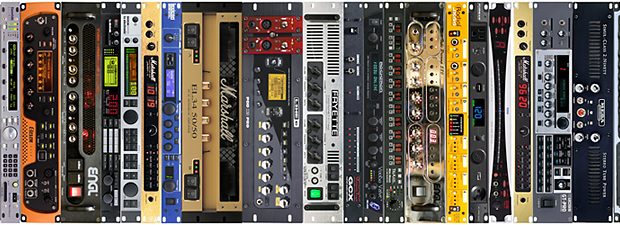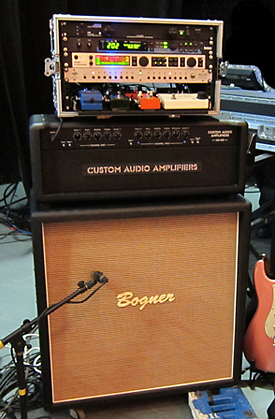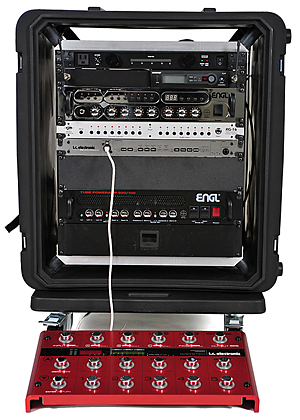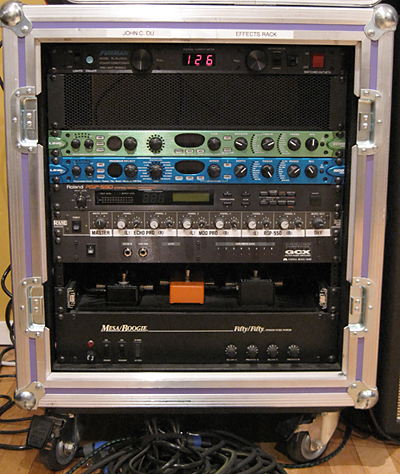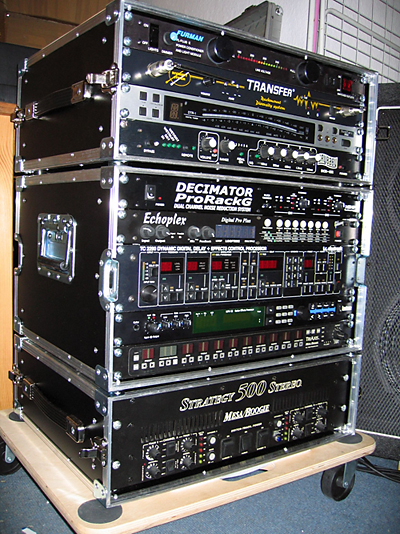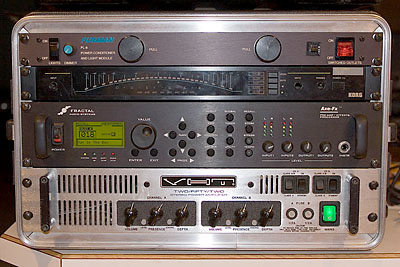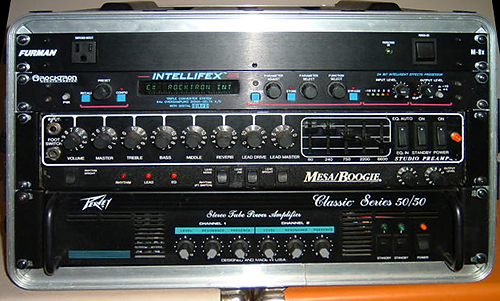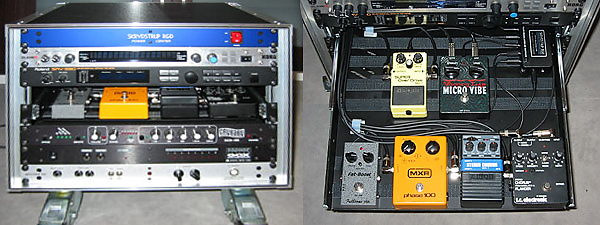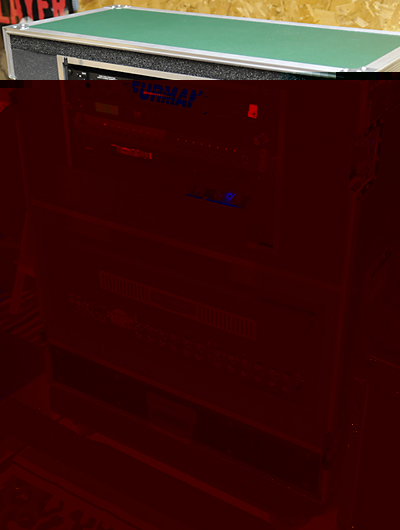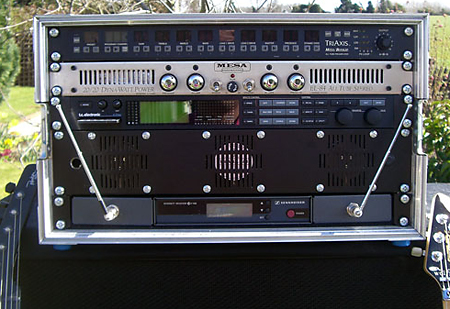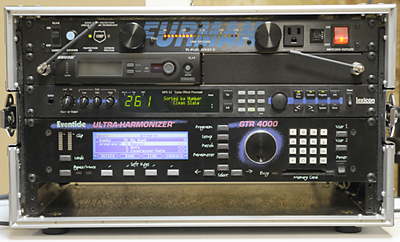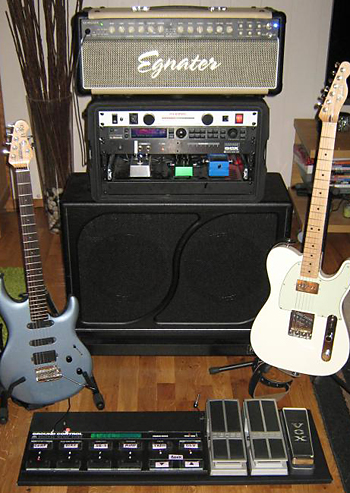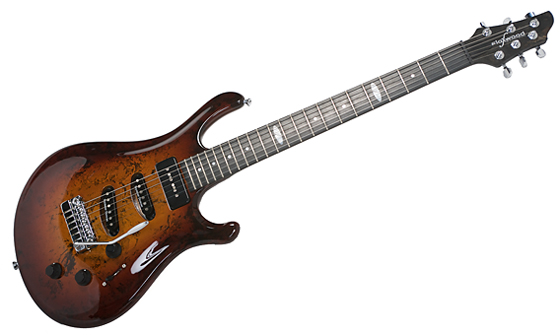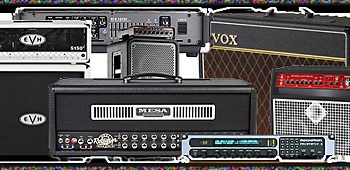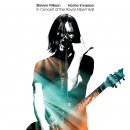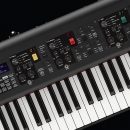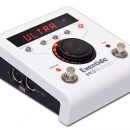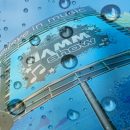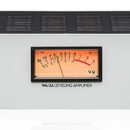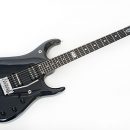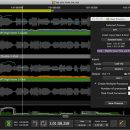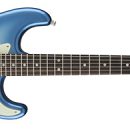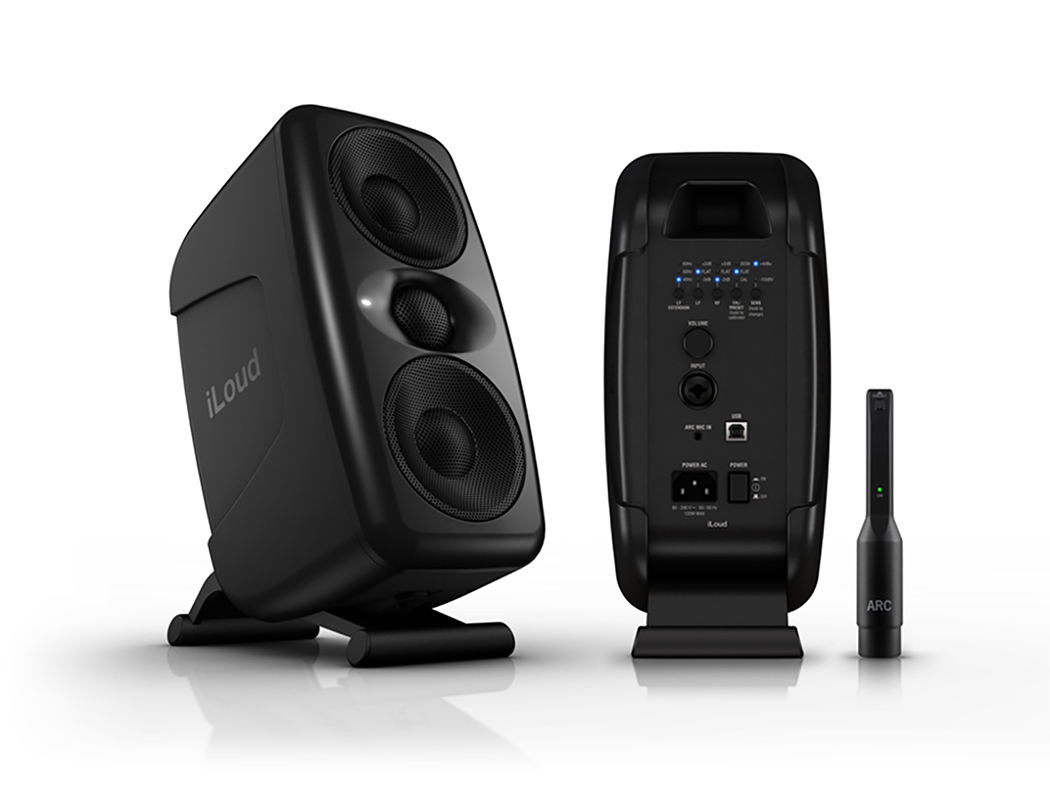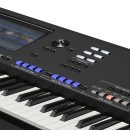Renewed Interest in Rack Gear Means Numerous Options for the Modern Guitar Player
 Many things in the music industry are cyclical, as evidenced by the resurging popularity of music influenced by Eighties artists. In rock and metal, there are more new AOR, glam, shred, and prog rock bands worldwide than we’ve seen in the past decade. And, with an interest in more technical, polished music performance comes an interest in guitar rigs that provide extreme flexibility to the discerning guitar player.
Many things in the music industry are cyclical, as evidenced by the resurging popularity of music influenced by Eighties artists. In rock and metal, there are more new AOR, glam, shred, and prog rock bands worldwide than we’ve seen in the past decade. And, with an interest in more technical, polished music performance comes an interest in guitar rigs that provide extreme flexibility to the discerning guitar player.
Rack gear has long been the serious shredder’s path to ultimate flexibility. Why settle for three or four amp channels when you can store a seemingly infinite number of amp tones and crazy effects (from pedals or rack gear), all accessible at the touch of a single button on a foot controller?
Although there have been many people lamenting the death of rack gear over the past ten years, we’re happy to report that they’ve been dead wrong. Rack gear may not be in the spotlight, but the list of pro players with at least some rack gear in their rigs is endless.
Today there are more new rack products for guitar players than ever before! Back in the ‘80s, most guitarists were taking signal processing gear from recording studios and putting it in their guitar rigs with varying degrees of success (and complexity) as they sought effects with better audio quality than most pedals offered, but these days, almost everything you’d like to put in your rack has been designed expressly with guitar players in mind. Plus, you can even rack your pedals and have instant access control over the whole collection with single-button simplicity.
From tube preamps and power amps to modelers to pro tuners to wireless systems to analog pedal loopers and (of course) multi-effects processors, there’s a huge assortment of rack gear designed to take your guitar inspiration (and tone) to a higher level.
Rack gear isn’t just for players who like a ton of effects. As we mentioned, virtually every touring pro has at least some rack gear in his rig — effects or not. Rack gear provides supreme flexibility for any style of guitar player looking to simplify his or her use of multiple amp tones and effects. This might include making use of specialized studio effects or it might just be a way to simplify the madness of tap dancing across a pedalboard stocked with your favorite boutique pedals.
Rack Gear is a broad category of products that can either work with your existing amp or replace it entirely, providing a wide range of options. It includes amps, effects processors, power conditioners, wireless systems, and much more.
Most guitar players only use a single amp and a few pedals, so getting started with rack gear can seem like a daunting ordeal. Where do you start if you haven’t made the leap yet? You may have been discouraged by crazy stories from friends and things you’ve read in online forums such as: the complexity of programming rack gear, tube gear in a rack doesn’t sound as good as a head, you have to learn MIDI, and more.
We’ll separate the urban myths from reality as we explore rack gear from the ground up and help you to understand the various ways in which it can either expand your current guitar rig or maybe even replace it. Plus, we'll show you photos of various racks from pros and amateurs alike.
Rack Gear Defined
Simply put, rack gear is any piece of music equipment or accessory that is built within a 19” wide chassis that can be screwed into an equipment rack. But even that simple description doesn’t tell the whole story.
For players using rack gear to control effects pedals (stomp boxes), those pedals can easily be placed on standard 19” wide shelves and installed along with more traditional rack gear.
Players who love their amp heads can have those full-sized giants loaded into custom-built rack cases that hold the heads along with standard 19”-sized rack gear. Most pros on major tours have rigs build like this, but even the weekend club player can benefit from the same kind of setup. See our in-depth review of custom rack head cases here.
Some of the benefits of rack gear can be experienced immediately by anyone playing live shows on a regular basis, whether it’s a pro tour or you’re just hitting the local bars and clubs on weekends. Your pricey gear can be extremely well protected inside of equipment racks, many of which are rated to meet airline transportation or military specs, and if your entire rig is contained within a single rack, setup time at a gig can take less than one minute — just plug in your speaker cabinet, instrument cable, and foot controller. Three or four cables, and you’re all set!
 Rack gear tends to fall into three primary categories of products:
Rack gear tends to fall into three primary categories of products:
- Amps: guitar preamps and power amps specifically designed for installation into 19” racks.
- Effects: multi-effects processors or dedicated effects processors (like delay or reverb units).
- Accessories: pedal loopers (for controlling your stomp boxes), tuners, wireless receivers, and more.
Rack Guitar Amplifiers
Guitar players have been sticking our heads in racks for decades (heck, we’ve put our heads up our… well, you know. Just ask our wives/girlfriends). In fact, one of the first options came from Mesa/Boogie, whose classic Mark II and IV heads were available in 19” wide enclosures that could be rack mounted without special modification.
But when we discuss rack amps today, we’re typically referring to modular gear. Rack-mounted guitar amps provide the ultimate flexibility when it comes to tone. The preamps and power amps (which collectively make up your traditional head or combo amp) are each contained in separate, rack-mountable chassis.
The advantage of this design is that it provides very flexible tone options — more than you’ll find with virtually any traditional tube amp or head. You can mix a preamp from one company with a power amp from another to create a truly one-of-a-kind tone, or select from among multiple power amp options within a single company to get just the right kind of tone you desire.
For example, Mesa/Boogie has multiple power amps with 6L6 power tubes as well as one with EL-84 tubes. Within the 6L6 tube family, Mesa/Boogie’s power amps offer vastly different power ratings as well as other differences in design (Simul-class, dual rectifier, etc.) that each contribute to a significantly different guitar tone.
It’s not just about 6L6 vs. EL-34 power amps, either. Many rackable tube preamps contain memory for storing multiple presets. Rather than just choosing between a couple of channels like with a typical two- or three-channel head, imagine a head that lets you dial in your amp tone and then save a hundred different presets! Using any popular MIDI foot controller, you can have direct access to multiple different sounds within a single preamp.
Just because there may be digital technology at work for selecting your sounds, there’s no need to worry about your tone. The sound from racked preamp and power amps can still be one hundred percent tube, and the most popular preamps all feature multiple 12AX7 or ECC83 tubes just like your favorite traditional amp. Likewise, power amps feature the usual assortment of power amp tubes (6L6, EL-34, EL-84, etc.).
Not all guitar preamps feature tubes, however. There are numerous solid-state guitar preamps on the market, not to mention a wide variety of modeling products that can all be paired with tube power amps to combine tonal variety with tube warmth.
Another great advantage of rackable preamps: stereo operation! Almost all rackable guitar preamps offer stereo effects returns and stereo master outputs.
Popular Rackable Preamps
For extreme flexibility and tube goodness, you can’t beat preamps such as the ENGL e580, Mesa/Boogie Triaxis, Egnator M4 and Randall RM4, or the recently discontinued Marshall JMP-1. Analog purists who don’t need the whole kitchen sink but want at least a few traditional amp channels can find bliss in the ENGL e530 Modern or Mesa/Boogie Rectifier Recording Preamp, which have simple two/three channel interfaces just like you’d find on a head or combo.
If you’re a modeling fan, it’s hard to beat the flexibility of preamps like the Fractal Audio Axe-FX, Line 6 POD X3 Pro, BOSS GT-Pro, or Avid’s new Digidesign Eleven Rack. Besides modeling classic tube amps, these products also include multi-effects processors built in for added flexibility (not to mention a host of other special features).
For players seeking non-modeled, solid-state preamp tone, options abound for you, too. Check out the Rocktron Prophesy II or Voodoo Lab Guitar Preamp to hear what you can do without tubes in the preamp section.
The used gear market is another source of popular rackable preamps. The Marshall JMP-1 MIDI Tube Preamp was only recently discontinued but enjoys a huge following from pro players and amateurs alike, and we know more than a few players who still love the classic ADA MP-1, not to mention a variety of preamps that were made by Peavey.
In almost all cases, dialing in your sound on rack preamps is the same process as you go through with your traditional heads and combos. You turn knobs for gain and EQ, loop levels, etc., hit a few buttons or flip a few switches for different preamp voicing options, and then you may have a few button pushes to save your settings in the preamp’s memory.
In the case of simple two-channel preamps like the Mesa/Boogie Rectifier Recording Preamp, you just dial and play. The intimidating looking Triaxis has soft membrane buttons for changing your “virtual” knob values, but don’t be scared: inside it’s all analog.


Guitar players can mix and match preamps and power amps from different manufacturers to get truly one-of-a-kind tone.
Popular Rackable Power Amps
It should come as no surprise that many of the companies building tube preamps offer a variety of power amps. Check out a wide range of all-tube stereo power amps from ENGL, Mesa/Boogie, Randall, Marshall, Carvin, and Fryette.
If you’re looking to test the waters first, the used market has plenty of Peavey rackable tube power amps. We still have a Peavy Classic 50/50 (not to be confused with a similar-named combo amp) loaded with EL-84 tubes in our studio.
Rack Bass Amplifiers
Bass players have always embraced rack gear. The majority of bass amps come standard in 19” form factors and are easily transplanted from their shells into the rack of your choice. But with the majority of rackable bass rigs (unlike the guitar gear), bass preamps and power amps are typically integrated into a single unit. Tubes aren’t as big a deal for nearly as many bassists as they are to guitar players.
Exceptions to the Rule
With all these separate preamps and power amps, it was only a matter of time before new rack-optimized all-in-one solutions were born. Check out Rhodes Amplification, a boutique builder from Indiana. They make full guitar amps specifically in 19" rack-mount enclosures, like the Assassin amp pictured below.

Rack Effects Processors
One of the most popular categories of rack gear for guitar players is multi-effects processors. It’s very easy to replace a large number of pedals from your pedalboard — like modulation, delay, reverb, compressor, and tuner — with a single device that includes all of these effects and more (noise gates, filters, wahs, etc.).
Historically, before multi-effects processors came along, guitar players ransacked studio gear to build guitar rigs with their album effects intact. One of the most popular digital delay processors of all time is the TC Electronic 2290, which is still a highly sought processor on the used market. You can obtain similar delay sounds from newer TC Electronic gear, but none of those products are built with the precise functionality (or analog circuitry) as this legendary product. We’ve inquired about the possibility of a 2290 reissue, but sadly many of the components used to build the 2290 just aren’t available any longer, nor would it be possible to make a true reissue ROHS compliant.
Eventide harmonizers were widely implemented in guitar rigs, and eventually Eventide released a few models optimized for use in guitar rigs. Also popular were rack processors from KORG, Yamaha, and Roland.


Great sounding effects in one small piece of rack gear can replace your chorus, delay, reverb, tuner, compressor, and more!
Multi-effects processors are a great place to start exploring the world of rack gear. These products can open you up to a whole new world of fantastic sounds, and since the foot switches aren’t built in as with your pedals, you control these processors via MIDI foot controllers.
With MIDI foot controllers, you can instantly select from multiple presets that you’ve saved, and you can also turn individual effects blocks On and Off just as if you were stepping on individual pedals on a pedalboard. See our detailed tutorial on MIDI foot controllers when you’re ready to learn more about using these products to control your rack gear.
One distinguishing feature among various multi-effects processors has to do with whether or not the product has a preamp circuit built in. Obviously, all of the modeling products do, but some classic multi-effects processors such as the Lexicon MPX-G2 also have preamps or drive/distortion circuits. Most multi-effects processors do not have preamp circuits, though, and we think this is a smart decision. Start with great tone from your tube amp or preamp and then used these products for effects other than distortion and overdrive.
Popular Multi-Effects Processors
Today, processors like the TC Electronic G-Major II (and the G-Major before it) are among the most popular products for guitar players looking to add some rackable effects to their rigs thanks to their studio-quality sound, easy programmability, guitarist-optimized features, and very reasonable pricing. For the cost of a couple of premium pedals, you can put a lot of creative power in your rig and eliminate the use of many pedals. Players looking at an easy path into rack-based effects processing should check these out, along with the Digitech GSP1101 and Rocktron Xpression.
If your sights are set higher, popular effects processors used by touring and recording pros include the Eventide Eclipse, TC Electronic G-Force, Fractal Audio Axe-FX, and the TC Electronic G-System.
Of course the true cost for most of these products increases once you add a foot controller plus the actual rack case to hold your gear, so don’t forget to factor in some additional money when considering implementing rack gear in your rig.
For studio use and home recording, you can certainly control effects processors from their front panel without needing a foot controller — you just won’t have instant On/Off access to effect blocks (unless you can hit the buttons with your toes while you’re playing).
On the used market, some classic processors still widely respected include the previously mentioned Lexicon MPX-G2 and a variety of processors from ART and BOSS. However, considering how much technology has improved, if you’re excited about adding some rack effects to your rig, we’d recommend investing in the new gear. You’ll have a much easier time editing effects (many new products have computer-based software editors) and while the audio quality of some vintage rack effects is great, those devices don’t always provide instantaneous transitions from one sound preset to another. You don’t want an audible click or gap each time you step on a button to select a new preset.
Popular Single-Effects Processors
For processors with singular functions, there are numerous dedicated digital reverb units from Lexicon, and the TC Electronic D-Two delay processor has some very cool capabilities that aren’t available in other products, such as the ability to manually tap in rhythmic patterns for your repeats.
Also hard-to-come-by (but highly desired) on the used market is a series of rack-mounted effects processors from Line 6: the Mod Pro, Echo Pro, and Filter Pro. These boxes took Line 6’s modeling pedal technology and added MIDI control over all settings, tap tempo that could sync to MIDI clock, and memory for tons of presets. If you want these great sounds today, be sure to check out the POD X3 Pro, which has many of them, plus a whole range of other capabilities including amp modeling and computer-based editing of your effects.
Many pros use the Dunlop Crybaby rack-mounted Wah system, too. The advantage is that the long cable run to your foot pedal doesn’t carry any audio signals – the actual wah tones are located close to your amp or preamp. Rackable chorus units are also available.
What About Floor-based Multi-Effects?
Products like the BOSS GT-10, POD X3 Live, and DigiTech RP1000 have many of the capabilities of rack-based processors, plus have the benefit of a foot controller already built in. However, these products rarely have the same kind of flexibility and premium sound quality that dedicated rack gear offers, and they almost never have the same level of MIDI capabilities as dedicated foot controllers. Some of these products are quite capable, though, and do have pro-level audio specs.
We know a lot of touring guitarists who have implemented the TC Electronic Nova System, incorporating it onto their pedalboards and replacing numerous other pedals with it (or replacing their big pedalboards entirely with the Nova System for fly-away gigs). Products like this one raise the bar for floor-based products as they deliver studio quality tone in a compact package.
For players looking at an in-between solution, the Line 6 M9 and M13 also straddle a fine line between the needs of the pro player and the desire to keep things as simple as possible in a self-contained floor unit.
The Signal Chain: Pros and Cons of Multi-Effects Processors
Placement of effects in your signal chain is a question sure to be on the minds of many players making the leap to rack gear from a pedalboard full of fantastic sounds. Although no rules are one hundred percent when it comes to guitar rigs, there are some popular configurations of gear that the majority of players use.
The greatest advantage pedals (stomp boxes) have over multi-effects processors is the total flexibility you have in setting the order of the signal chain. You can very easily place certain pedals in front of your amp and others in the effects loop.
Filters and wahs, overdrive, and distortion typically get placed in between the guitar and the amp’s input jack. Effects like modulation, delay, and reverb typically get placed in an amp’s effects loop (post-EQ), while some effects are widely used in either location depending on your need.
For example, a noise gate in front of the amp is great for reducing noise from single-coil pickups, whereas a noise gate in the effects loop is great for reducing noise from high-gain amplifier sounds. And a chorus pedal can have a great, but different, sound whether it’s placed in front of your amp or in the loop — it’s really just a personal artistic preference sometimes.
One challenge with rack effects gear is that you typically have an all-or-nothing approach to effect placement. You may be able to rearrange the sequence of effects in front of or behind each other (or in parallel) — i.e. place the delay before the chorus, but commonly the entire effects unit has to be run in your amp’s effects loop or in front of the input jack (and most rack gear is optimized for loop-only operation with balanced or line-level I/O).
A few models, such as the TC Electronic G-System, Digitech GSP1101, and BOSS GT-Pro have insert loops that enable you to route some effects to the front of your amp and other effects to your effects loop in order to eliminate this problem. The wiring scheme for implementing these solutions is commonly called the four-cable method as this describes how many cables are needed for the connections (and five cables with stereo rigs).
Rack Accessories: Power, Pedal Loopers, and More
Power Conditioners
If you own a high-quality tube amplifier, you should be plugging it into a power conditioner; not a cheap power strip. These devices filter the AC power, which can result in quieter tube amp operation devoid of electrical noise, and they regulate the voltage, ensuring a constant level of power to your amplifier. This results in longer tube life and more consistent amp response. The overwhelming majority of line conditioners are only available in rack form, and the industry leading products today come from Furman and Monster. We particularly love the Furman PL series conditioners.
Rack Tuners
Rack tuners have long been the staple of every touring pro’s rig, and the long-reining champion was Korg’s DTR-1 Pro. Who hasn’t noticed the Cylon warrior red dot moving back and forth from a rack behind some guitar player or bassist? Today, Peterson tends to be regarded the highest in this category, but Korg’s DTR series tuners are still widely used. There are plenty of units on the used market that tune your guitars just as well as new models, and Behringer has a rack tuner priced lower than many pedals.
Don’t let the lack of rack tuners today worry you. There’s just limited need for them because most multi-effects processors have tuners built in, plus there are numerous pedal-based tuners available that provide the same basic functions. Rack tuners are useful, however, for players who use compensated tuning systems like BFTS or who regularly use alternate tunings. Also, some of the rack tuners provide multiple inputs so you can tune secondary instruments without plugging into the main rig, and some have extra features like a built-in microphone for tuning acoustic guitars or cable testers.
Pedal Loopers
When your pedalboard gets out of hand, covered with twenty of your favorite boutique and off-the-shelf pedals, it’s time for an advanced solution to help you put an end to the pedal tap dance… not to mention the loss of your high end frequencies if everything is patched in series!
Pedal loopers enable you to install your pedals on shelves in a rack and wire them into discrete, bypass-able loops. From a MIDI foot controller, when you select one of your saved presets, the pedal looper activates only the individual loops that you’ve chosen for the particular effect.

Stick your pedals on a rack shelf or in a drawer, connect them to the individual audio loops, and free yourself from the pedal tap dance!
For example, imagine that you have a clean boost pedal in loop 1, a chorus pedal in loop 2, a delay pedal in loop 3, and a reverb pedal in loop 4. A single stomp on your MIDI foot controller can activate your amp’s lead channel and the looper’s boost and delay loops for a ripping solo, and another stomp can instantly switch to your clean amp channel and the loops with pedals for chorus and reverb.
Besides simplifying control over your pedals, pedal loopers also clean up your tone. Pedals that aren’t in use get completely bypassed from the signal path.
Popular pedal looping products include the RJM Music Technology RG-16 and Effect Gizmo, the Voodoo Lab GCX, and the Skrydstrup MR-10, while companies like Custom Audio Electronics provide completely customized solutions.
Wireless Systems
Professional wireless systems today sound indistinguishable from the tone guitarists get from a premium quality cable (though guys with the $200 instrument cables will argue with you endlessly about this). If you want the freedom that wireless offers, you’ll want a rack to house the receiver safely.
The most popular professional wireless systems include the Shure SLX and ULX series, Line 6 X2 XDR and (soon, we predict) the new Relays series. There are also a wide range of less expensive wireless options from Sennheiser, Electro-Voice, Audio-Technica, and more. Typically, you get what you pay for with wireless, and many of the less expensive products do sound worse than a good cable — especially for bass players, who require an extended low frequency response that many guitar units are lacking. Be sure to consult some of our wireless reviews if you’re looking to set yourself free.
Other Gear
As guitarists build complex rack systems, there are a host of other products that may be incorporated into your rig. Special rack-mounted mixers and distribution systems are available for instant switching between multiple amps and guitar rigs, making it easy to get your clean tone from a Fender combo and your metal crunch tone from a Mesa/Boogie Dual Rectifier. Or, wouldn’t it be nice to leave a few different guitars plugged in and ready to go at the touch of a button?
Radial Engineering is one of the go-to companies for a variety of these advanced tools — their JX44 Air Control unit takes care of the guitar and amplifier switching.
What About the Actual Rack?
Now that you’re ready to build a rack setup, it’s time to find the right rack for your gear. They come in a wide range of sizes and materials, and offer different features that matter more or less to different players.
Most racks are built from plywood of differing thickness (anywhere from 3/8” to ½” to ¾”), which directly influences how heavy the rack is, and also what degree of protection it offers. Larger, heavier racks typically have casters, making it easy to roll them around, and handles on the sides for lifting.

Companies like SKB Case Co. and Gator are known for building racks out of polymer (plastic) materials that weigh a fraction of wooden cases, while offering similar protection values.
Shock racks provide the best protection for sensitive equipment like tube amps. These oversized racks are essentially racks inside of racks. Your equipment screws into the interior rack, and that rack is suspended either inside a layer of high-density foam or on a spring/coil suspension inside an exterior case shell. Both shock-mount solutions work well, providing fantastic isolation from bumps and drops, but shock racks are larger, heavier, and more expensive than the non-shock variety.
Rack sizes are measured in space units — a 4u rack is one that has four rack spaces for gear. A typical multi-effects processor is 1u or 2u tall, which designates how much space it will take up in a rack. Each unit is 1.75” tall.
You can build a small rack with a power conditioner, multi-effects processor, and wireless receiver quite easily. A small 3u or 4u rack doesn’t weigh much and is very portable. In fact, you can buy some small racks built right into nylon-covered gig bags — check out the Gator GRB Rack Bag if you need one of these.
If you’re building a large rig — ten spaces or more, there are numerous custom case builders who can build cases to your precise specs and colors. Calzone Case Co., Rock Hard, Maxline, Middle Atlantic, New York Case Company, Road Runner… an Internet search will reveal numerous builders. But there are plenty of large racks available from big companies like Calzone and SKB without having to custom order, too.
When you’re ready to rack your head, or even your speaker cabinets and combos, you’ll definitely want to talk with the custom case builders. Check out some of our case reviews to get some design ideas for your dream rig.
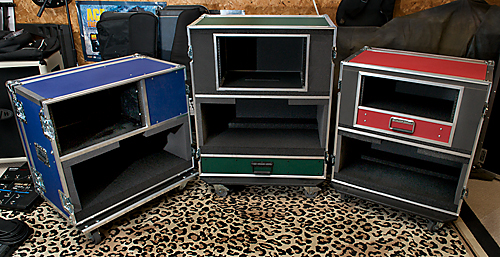
These custom cases hold your amp head and rack gear. Gig setup time? 30 seconds!
MIDI Foot Controllers
Does your amp have a footswitch with multiple buttons for channel selection, Solo/Boost, effects loop On/Off, Reverb, etc? Place that controller on a pedalboard with just a few other pedals and you’ve got a tough situation when you need to change multiple settings instantly (like cutting from a verse to a chorus or to a solo in the span of an eight note).

Go ahead and step on me. Who needs stomp boxes anyway?
MIDI foot controllers are programmable self-contained pedalboards that can control the various pieces of gear in your rack. Everything from selecting presets in your multi-effects processor to changing channels on your amp to turning on specific stomp boxes can be accomplished with a single button press.
MIDI — the Musical Instrument Digital Interface — is simply the communications technology used for sending commands from the foot controller to your rack gear. It’s the same technology used in keyboard rigs, except that guitar rigs only use a subset of what MIDI can accomplish.
For example, via MIDI a keyboard player can play on one keyboard and have it control (play/trigger) sounds from another keyboard or sound module located in a rack (or play virtual instruments running on a computer). In a guitar rig, though, MIDI is primarily used for sending program change (PC) messages to select different presets and continuous controller (CC) messages to turn individual functions in your rig On and Off (activating your chorus effect, muting your output for tuning, etc.) or for controlling some effects in real time, like manipulating a wah or whammy effect, or changing the volume/level of specific effects.
Our tutorial on MIDI foot controllers goes into depth exploring all aspects of using MIDI foot controllers, and also provides reference information about many different foot controllers on the market. We have reviewed a wide variety of popular foot controllers, so be sure to check our Reviews section, too.
Programming Rack Gear
Historically, configuring a rack system was complex, and many pros turned to professionals like Bob Bradshaw to design and configure their rigs. Today, Bradshaw is still building rigs for the stars, as well as for ordinary, obsessed musicians like you and I.
Fortunately, though, electronic musical equipment has gotten much easier to program and configure. If you are comfortable dialing in nice digital delays or selecting voicings for a harmonizer, you’ve got more than enough skills to program most of the current products. And by program, no, we don’t mean sitting down at a computer writing lines of Java or HTML code. We’re talking about setting values for your effects just as if you were twisting knobs on a stomp box, then saving those settings, and finally configuring your foot controller or other gear to remotely control the product.
Using a product like RJM Music Technology’s Effect Gizmo to gain single-button control over a floor (or rack shelf) full of pedals requires zero programming effort — you just push a variety of On/Off buttons for each effect loop and hold a Write button to save your settings. It really is that easy.
Programming your effects has gotten much simpler, too. Historically, we’ve got to attribute the programming horror stories to gear from Lexicon and Eventide. They built studio gear that required a lot of technical knowledge in order to program. And even when Lexicon made their guitar-specific MPX-G2, it was still just as complex to program and control via MIDI as any other piece of studio gear — they just added a few capabilities that made the unit guitar-centric in its focus.
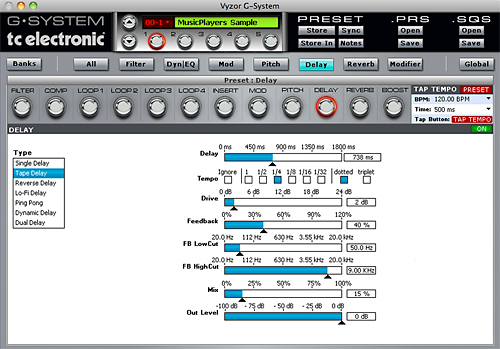
Editing effects today is easy thanks to computer-based software editors.
Happily, the interface on most guitar-related rack effects today is very straightforward. Processors like the TC Electronic G-Major II and G-System, Line 6 POD X3 Pro, and BOSS GT-Pro each have computer-based software editors for Macintosh and Windows. Rather than trying to set values on a small two- or three-line display, using an entire computer screen to show you everything graphically makes creating the sounds of your dreams quite easy.
Also, the software editors make it very easy to share presets with other musicians. Why reinvent the wheel when you can access a manufacturer’s online library of sounds and effects and just add new stuff created by fellow musicians and then just tweak the sounds to taste?
Where To Begin
As you can see, there is a wide range of products available that fall under the category of rack gear. For the modern guitar player, there are an incredible number of options that can either enhance your current guitar rig or replace it entirely.
If you love your amp, a multi-effects processor is most likely the first item you’ll want to start this rack love affair with. Something like the TC Electronic G-Major II or Rocktron Xpression can provide a fantastic sonic upgrade to your effects over your random pedal collection, and a MIDI foot controller will help you eliminate the pedal tap dance.
If you’re looking for some new tones, you can’t beat some of the rack preamps and power amps from ENGL and Mesa/Boogie. A Triaxis rig puts the entire collection of Mark-series tones in a small package with instant access, while the ENGL rigs can give metal and prog players an extremely diverse range of tones from studio clean to monstrously heavy. The Randall gear lets you mix and match a variety of different preamp modules to create a truly one-of-a-kind amplifier.
 There is plenty more when it comes to building complex guitar rigs, and we’ll explore advanced configuration options in a future article (series vs. parallel loops, wet/dry/wet rigs, custom cabling, etc.). Be sure to visit our Reviews section to read reviews of rack gear — we’ve taken an in-depth look at many of the products discussed in this feature.
There is plenty more when it comes to building complex guitar rigs, and we’ll explore advanced configuration options in a future article (series vs. parallel loops, wet/dry/wet rigs, custom cabling, etc.). Be sure to visit our Reviews section to read reviews of rack gear — we’ve taken an in-depth look at many of the products discussed in this feature.
If you crave flexibility, options, and stellar tone, break away from the pedal pack. Soon enough, you’ll be playing guitar according to my personal mantra: once you go rack, you never go back!
This feature only scratched the surface on the topic of rack gear. You can learn more about the subject in Scott Kahn's popular book, Modern Guitar Rigs: The Tone Fanatic's Guide to Integrating Amps & Effects.
The book covers a wide range of additional topics related to building a professional guitar rig. Learn more about it in our review section, or click here for discounted purchase links.
Rack Examples
From the biggest pros to regular, serious musicians and MusicPlayers.com readers, rack gear is used everywhere you look. Below, we've compiled an assortment of images to give you an idea of how various guitarists have implemented rack systems.We haven't identified every object in each rack, but have included some comments to give you an idea of what products are being used. If you hang out in various popular Internet forums, you may even recognize some of your friends' rigs.
On the next page of this feature, we've compiled photos from numerous racks that range from small to expansive. Check them out to get some creative ideas. Thanks to everyone for use of the rig photos!

